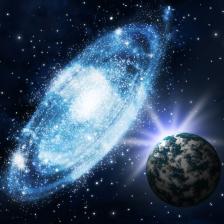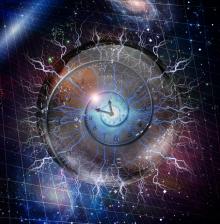Newton, Einstein, and Gravitational Waves
Ask Science explains the recent discovery of gravitational waves in the South Pole and what it means for our understanding of the Big Bang and the universe.
Lee Falin, PhD
Listen
Newton, Einstein, and Gravitational Waves

Isaac Newton Avoids a Zombie Plague
In the late 1660s, Isaac Newton was doing what most sensible people of means were doing, trying his best to avoid the bubonic plague by staying away from the big city. Newton had just graduated from Cambridge, but instead of heading off to party, he went back to his family’s farm at Woolsthorpe Manor and discovered calculus, some fundamental principles of light, and the law of gravity.
See also: Newton’s 3 Laws of Motion
Newton’s views on gravity can be summarized with these 3 points:
-
Every object in the universe exerts gravitational force on every other object in the universe.
-
The force exerted by one object on another gets weaker as that object moves further away.
-
This force affects things instantly. That is, it doesn’t take any time for the gravity of the sun to pull on the Earth. If the sun were to disappear, the Earth would instantly go careening off into space.
It’s All Relative

One of the biggest issues was the fact that Einstein’s research had led him to conclude that nothing, not even gravity, could travel faster than the speed of light. This meant that if the sun were to disappear, it would take some time for the Earth to go careening off into space. It would not be instant.
Under the general theory of relativity, time is just one more dimension in space. And space-time can be thought of like a big piece of fabric stretched across the cosmos. If you drop a heavy weight into the middle of the fabric, the fabric bends around that weight. Imagine the sun as a huge weight dropped into the fabric of space-time. The reason the Earth orbits the sun is that it is traveling around inside the bending of space-time created by the mass of the sun.
See also: What Is the Space-Time Continuum?
This is sort of like those giant plastic funnels you see at the shopping mall where you drop a coin into it and it goes around and around until it hits the bottom. But unlike the shopping mall version, there is no friction in space to make the Earth stop traveling around the sun, so it just keeps going, which is pretty convenient.
Catch the Wave
Now there are lots of other things predicted by this general theory of relativity. One of those predictions is the concept of gravitational waves. If you go back to that mental image of space-time as a big piece of stretched fabric, a gravitational wave would be the disturbance caused when large masses are moving around on the fabric.
If you’ve ever played popcorn on the trampoline, gravitational waves are sort of like that. In that game, one person bounces up and down on the trampoline, while everyone else sits curled up in a ball, with their arms gripped tightly around their knees. The object of the game is to cause enough of a disturbance to make people lose their grip.
Just like the trampoline version, as a mass causes a disturbance in the fabric of space-time, gravitational waves travel outward, rippling through the fabric of space-time. One difference between real gravitational waves and our trampoline analogy is that while we can see the effects of these gravitational waves, they are so extremely small that they have been very difficult to detect.
However, recently scientists working at an observatory at the South Pole have been able to detect the effects of gravitational waves on light waves. These waves are thought to be the result of the gravitational disturbances caused by the rapid expansion of the universe after the Big Bang. Scientists are pretty excited about this discovery, because if confirmed, these results not only provide more information on the birth of the universe, but also supply us with one of the last pieces of evidence for the predictions made by Einstein’s general theory of relativity.
Check out Math Dude’s episode What Physics Recently Discovered About the Big Bang for more about this amazing discovery.
Conclusion
So now you know a little more about gravity, the differences between Newton’s view of gravity and Einstein’s view of gravity, and just what’s so exciting about gravitational waves.
If you liked today’s episode, you can become a fan of Ask Science on Facebook or follow me on Twitter, where I’m @QDTeinstein. If you have a question that you’d like to see on a future episode, send me an email at everydayeinstein@quickanddirtytips.comcreate new email.
Galaxy image courtesy of Shutterstock.

